|
|
Created/dedicated as per personal communication with K L. Thalin, September 1, 2010
Updated as per James P. Tuttle's The Hawk Moths of North America, September 1, 2010
Updated as per Butterflies and Moths of North America website, formerly USGS; now BAMONA, September 1, 2010; updated July 26, 2014
|
Windham County, Southeastern Vermont
Sphingidae
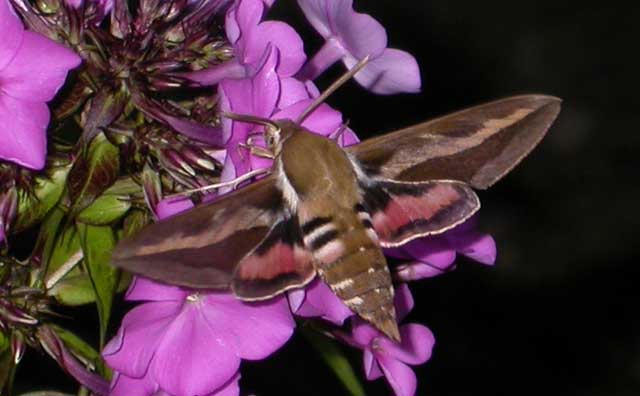
Hyles gallii, Saxton's River, Windham County, Vermont,
August 12, 2007, courtesy of K. L. Thalin.
This page, depicting the Sphingidae from Windham County, Vermont, is inspired by and dedicated to K. L. Thalin
who sent me the images of Hyles gallii at the top and bottom of the page, as well as the images of Paonias excaecata
and Smerinthus cerisyi immediately below.
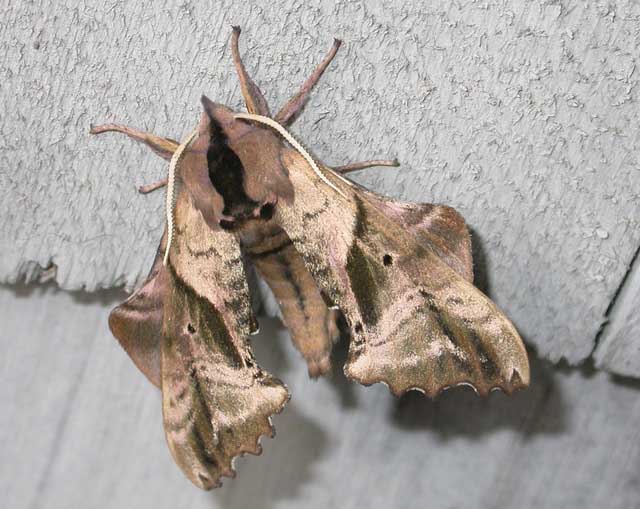
Paonias excaecata, Saxton's River, Windham County, Vermont, courtesy of K. L. Thalin.
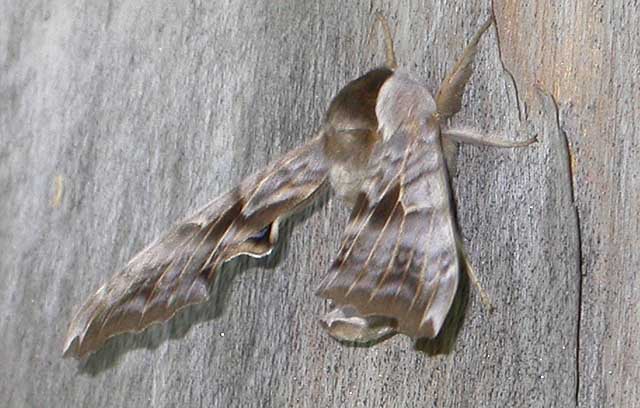
Smerinthus cerisyi, Saxton's River, Windham County, Vermont, courtesy of K. L. Thalin.
K. L. Thalin writes, "I have been in contact over the last week or so with Daniel Marlos, host of the site "What's That Bug?". He identified a
crazy-looking wasp I photographed as a Giant Echneumon and is featuring it as the 'September Bug of the Month. I submitted these two photos
(Hyles gallii) to him this morning.
"You're most welcome, and yes, you have my permission to post the images. Please send me the link when you have it all created! That's great!"
Seventeen Sphingidae species (Twenty-three as of July 26, 2014) are listed for Vermont on the U.S.G.S. website. None of those species are reported in
Windham County as of September 1, 2010. Six are reported as of July 26, 2014: (Amorpha juglandis, Lapara bombycoides,
Pachysphinx modesta, Paonias myops, Amphion floridensis, Hyles gallii).
I have, however, added many species which I feel are probably present in Vermont (not reported) and in Windham
County. It is hoped that this checklist, with the thumbnails and notes, will help you quickly identify the moths you are likely to encounter.
A "WO" after the species name indicates that I have no confirmed reports of this species in your county, but I
(William Oehlke) expect that this moth is present. A "USGS" indicates the moth is reported in Lepidoptera of North America,
#1. Distribution of Silkmoths (Saturniidae) and Hawkmoths (Sphingidae) of Eastern North America,
an excellent little booklet available through Paul Opler.
Please help me develop this list with improved, documented accuracy by sending sightings (species, date, location), preferably with an
electronic image, via email to Bill Oehlke.
Please also send your sightings to BAMONA, an excellent online resource.
Visit Windham County Sphingidae Larvae: Caterpillars; Hornworms
Visit Vermont Catocala: Underwing Moths
Sphinginae subfamily
Sphingini tribe:
 |
Agrius cingulata, Pink-spotted Hawkmoth,
fall stray
This moth is a very strong flier, but would only make its way to
Vermont as a rare stray. There are not too many records from Vermont, but records exist for NY, NJ and CT.
It has been reported in Washington Co., VT.
|
 |
Ceratomia amyntor
WO,
the Elm Sphinx or Four-horned Sphinx
The upperside of the forewing is brown with dark brown and white
markings including a white costal area near the wing base, dark
streaks along the veins, and a white spot in the cell.
Larvae feed on Elm (Ulmus), birch (Betula), basswood (Tilia), and
cherry (Prunus). |
 |
The upperside of the forewing is pale brownish gray with wavy black
and white lines and a black-outlined white cell spot. The upperside
of the hindwing is gray with diffuse darker bands.
|
 |
The upperside of the forewing is dark brown with a dusting of white
scales. Some moths have patches of reddish or yellowish brown on the
wings.
|
 |
The upperside of the forewing is gray with heavy black bands. The
upperside of the hindwing is brownish gray with no markings.
|
 |
Lintneria eremitus
WO,
the Hermit Sphinx:
The upperside of the forewing is gray-brown with wavy lines, black
dashes, and one or two small white spots near the center of the
costa. The upperside of the hindwing is black with two white bands
and a triangular black patch at the base.
Note the golden hair on the thorax.
|
 |
The moth abdomen usually has five but sometimes six pairs of yellow
bands. The upperside of the forewing is blurry brown and gray.
|

|
Sphinx canadensis
WO,
Sphinx canadensis, the Canadian Sphinx, is not common, and is not
often reported anywhere,
but it may be in Windsor County.
Larval hosts are white ash (Fraxinus americana) and blueberry
(Vaccinium).
|
 |
Sphinx chersis
WO,
the Northern Ash Sphinx or Great Ash Sphinx
The upperside of the forewing is soft dark gray to blue-gray with
a series of black dashes, one of which reaches the wing tip.
|
 |
TForewings, long and slender, are held close to the body when the
moth is at rest.
|
 |
This species is probably present in Windsor County.
Colouration and markings are highly variable from one specimen to
another. The fringes on forewing are mostly
black with some white; those on the hindwing are mostly white with a
few black patches.
|
 |
The lower forewings are predominantly brownish-yellow with a fairly
wide dark bar along the inner margin. At rest the wings hug the body,
giving the moth a long slender look.
|
 |
Sphinx luscitiosa
WO,
the Canadian Sphinx or
Clemen's Sphinx
The upperside of the forewing is yellowish gray in males and pale
gray with a faint yellow tint in females. In both sexes, the dark
border on the outer margin widens as it approaches the inner margin.
|
 |
If you have blueberries in the woods, then you probably have the
Poecila Sphinx.
They are pretty common here on Prince Edward Island in eastern Canada.
They are reported as far south as northeastern New York.
|
Smerinthini Tribe:
 |
The adults are also highly variable; sometimes wings of an individual
may be all one color or may have several colors, ranging from pale to
dark brown, and may have a white or pink tinge.
See the file for the female; she is different. |
 |
Pachysphinx modesta
WO, the Modest Sphinx or Poplar Sphinx
This moth has a large, heavy body, and females can be remarkably
plump.
They are common on Prince Edward Island. |
 |
Named for the dull grey-blue spot in the hindwing, this moth has a
wide distribution and is probably common in Windsor although not
officially recorded.
I regularly see them on Prince Edward Island, and they are reported as far south as Florida. |
 |
Named for the small eye-spot in the hindwing, this moth has a
wide distribution
and is probably common in Windsor although not reported.
I regularly see them on Prince Edward Island, and they are reported as far south as Florida.
|
 |
Smerinthus cerisyi antennae typically rest alongside head and thorax and forewings generally
conceal hindwings. This is a very easy species to rear.
|
 |
Smerinthus jamaicensis closely resembles
Smerinthus cerisyi, but jamaicensis is much smaller
with larger blue patches on more vibrant and deeper purple in the
lower wings. |
Macroglossinae subfamily
Dilophonotini tribe:
See Hemaris comparison to help
distinguish the next three species.
 |
Hemaris diffinis
WO, the Snowberry Clearwing or
Bumblebee Moth
Adults mimic bumblebees and are quite variable, both geographically
and seasonally. The wings are basically clear, with dark brown to
brownish-orange veins, bases and edges. The abdomen tends to be dark (black) with
1-2 yellow segments just before the terminal end.
|
 |
Hemaris gracilis
WO, the
Slender Clearwing or Graceful Clearwing
Hemaris gracilis is distinguished from similar species by a pair of
red-brown bands on the undersides of the thorax, which varies from
green to yellow-green dorsally and sometimes brown with white
underneath. They have a red abdomen.
|
 |
Hemaris thysbe
WO, the Hummingbird Clearwing
It is not difficult to see why many gardeners would mistake an
Hemaris thysbe moth for a small hummingbird as it hovers,
sipping nectar from flowers through a long feeding tube.
|
Philampelini tribe:
 |
This moth has beautiful pink hindwings. Larvae get quite large and
are often found on grape foliage or crawling on the ground
seeking some soft earth for tunneling and pupation.
|
 |
If you have Grape or Virginia Creeper nearby, then you probably have
this species.
I often get asked to identify larvae from areas where they have not
previously been reported.
|
Macroglossini tribe:
 |
This day flier is widely distributed. If you have Virginia Creeper,
you probably have the Nessus Sphinx.
Two bright, distinct,
narrow yellow bands are often visible on the abdomen.
|
 |
They are common in New Jersey and common
here on Prince Edward Island.
You will often see this species listed as Darapsa pholus,
especially in older literature. I suspect they are present.
|
 |
Darapsa myron
WO, the Virginia Creeper Sphinx or the Grapevine Sphinx
This moth is recorded on the U.S.G.S. site for Windsor County.
It is widely reported as far north as southern Maine. If you have the
foodplants indicated in the common names, you probably have this
species nearby.
|
 |
Darapsa versicolor
WO,
the Hydrangea Sphinx:
Fw upperside is often greenish brown with
curved dark lines and pinkish-white patches.
Hw upperside is pale yellow to reddish brown with white
along the costal margin, greenish brown along the outer margin, and
white shaded with greenish brown on inner margin.
|
 |
The moth's outer margin of the forewing is deeply scalloped.
The upperside is light brown with dark brown markings.
There is a small black and white spot near the tip.
The upperside of the hindwing is orange-brown with a dark brown outer margin and median line.
|
 |
Hyles gallii
WO, the Bedstraw Hawk Moth
or Gallium Sphinx
This species is reported in Windsor County by Beth Anderson.
Some years I see them on P.E.I., some years, I do not.
|
 |
Hyles lineata
WO; possible stray, the White-lined Sphinx
This species is not reported from Windsor County.
It is a strong migrator from the south,
and has been seen in northern New Hampshire.
|
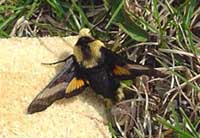 |
Proserpinus flavofasciata
WO, the Yellow-banded Day Sphinx
This species is not officialy reported from Windsor County.
Adults fly as a single brood from April-June in meadows in coniferous
forests. Adults fly during the afternoon. possibly in northern Windham
|
 |
This moth is very much under reported. It is a
rapid day flier so is probably not in too many collections.
Grape is a popular larval host.
|
|
|
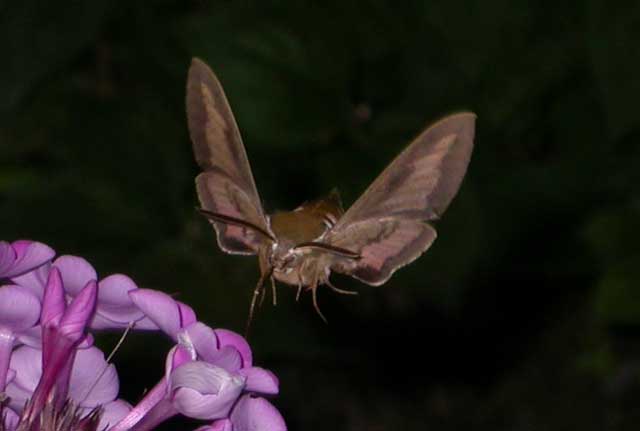
Hyles gallii, Saxton's River, Windham County, Vermont,
August 12, 2007, courtesy of K. L. Thalin.
Enjoy some of nature's wonderments, giant silk moth cocoons.
These cocoons are for sale winter and fall. Beautiful Saturniidae moths will emerge the following spring and summer.
Read Actias luna rearing article.
Additional online help available.
Eggs of many North American species are offered during the spring and summer. Occasionally
summer Actias luna and summer Antheraea polyphemus cocoons are available. Shipping to US destinations is done
from with in the US.
Use your browser "Back" button to return to the previous page.
This page is brought to you by
Bill Oehlke and the
WLSS. Pages are on space rented from Bizland. If you would like
to become a "Patron of the Sphingidae Site", contact Bill.
Please send sightings/images to Bill. I will do my best to respond to
requests for identification help.
 | 
Show appreciation for this site by clicking on flashing butterfly to the left.
The link will take you to a page with links to many insect sites. |
This website has been created and is maintained by Bill Oehlke without government or institutional financial assistance. All expenses, ie., text reference
support material, webspace rental from Bizland, computer repairs/replacements, backups systems, software for image adjustments (Adobe Photoshop; L-View),
ftp software, anti-virus protection, scanner, etc. are my own.
I very much appreciate all the many images that have been sent to me, or of which I have been granted permission to copy and post from other websites.
All images on this site remain the property of respective photographers.
If you would like to contribute to the maintenace of this website by sending a contribution to
Bill Oehlke
Box 476
155 Peardon Road
Montague, Prince Edward Island, C0A1R0
Canada
your donation would be much appreciated and would be used for
1) paying for webspace rental;
2) paying for computer maintenance and software upgrades;
3) purchases of additional text reference material (journals and books) in anticipation of expanding the site to a worldwide Sphingidae site;
4) helping to pay my daughter's tuition (completed spring 2013); with anything left over going to humanitarian aid.
If you are mailing a check from USA, please use $0.85 postage ($1.15 is 2014 rate; check with local post office first as rates are increasing almost annually).
Donations can also be made through Paypal via the button below.




